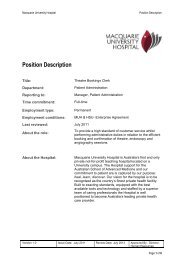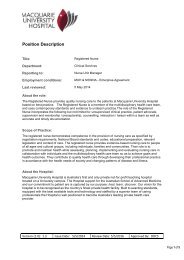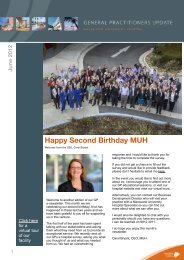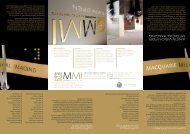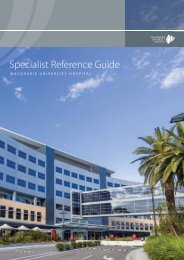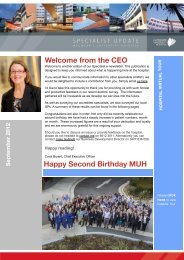Plenary Oral Presentations - Macquarie University Hospital
Plenary Oral Presentations - Macquarie University Hospital
Plenary Oral Presentations - Macquarie University Hospital
You also want an ePaper? Increase the reach of your titles
YUMPU automatically turns print PDFs into web optimized ePapers that Google loves.
16 th International Meeting of the Leksell Gamma Knife ® SocietyMarch 2012, Sydney, AustraliaBE-298Radiosurgery for Pineal Tumours: Lessonsfrom a Single Unit’s Experience1Jeremy Rowe, 1 John Yianni, 2 Nader Khandanpour, 1 Gabor Nagy,2Nigel Hoggard, 1 Matthias Radatz, 1 Andras Kemeny1National Centre for Stereotactic Radiosurgery, Sheffield, UK.2Dept Radiology, Royal Hallamshire <strong>Hospital</strong>, Sheffield, UK.Objective: Pineal tumours present management dilemmas. This reflects their varied histology, andthe hazards of surgical approaches. These issues prompted a systematic review of our radiosurgicalexperience to rationalize future therapeutic choices.Methods: From 1987-2009, 44 patients (66% male) underwent 50 Gamma Knife radiosurgicaltreatments. Mean(±SD) age at first radiosurgery was 34±16 years. Twenty-four patients had definitivehistology (11 pineal parenchymal tumours(PPT), including 2 pineoblastomas, 6 pineocytomas and 3 ofintermediate differentiation; 6 astrocytomas, 3 ependymomas, 2 papillary epithelial tumours, 2 germ celltumours(GCT)). Eleven patients had undergone surgery without a definitive tissue diagnosis: nine hadnot undergone surgery. Ten patients had received radiotherapy (5 PPT, 3 astrocytomas, 2 without tissuediagnosis).At treatment, mean tumour volume was 3.7±3.5cm3. Mean marginal dose was 18±4Gy.Mean follow-up was 62±53months (range 6-240). Radiological features were assessed blindly by tworadiologists.Results: Of 44 patients, five died 36±37 months after radiosurgery. Five further individuals showedradiological disease progression. Seven of these 10 patients had received radiosurgery as salvagetherapy. Malignant tumour histology (p=0.04), previous radiotherapy (p=0.002) and radiologicalevidence of necrosis (p=0.03) were associated with poor outcomes. Patients with none of thesefeatures had a 5 year progression free survival of 91% (80% at 10 years). If any of these featureswere present, the 5 year progression free survival fell to 48%. No complications were identifieddue to radiosurgery.Conclusions: Patients referred for radiosurgery are clearly super-selected. GCTs are under-representedin this series reflecting their established and effective treatment paradigms, and clearly they need to beidentified with blood/CSF markers and biopsy as appropriate. The finding that a quarter of this seriesdid not have a tissue diagnosis despite undergoing surgery, raises the question of how far it is mandatoryto pursue tissue diagnoses. The high control rate if no worrying features are present, combined with thelack of complications, suggests that primary radiosurgery without a tissue diagnosis is justifiable. Oncethere are concerns of malignancy, necrosis or failed radiotherapy, we suspect that a tissue diagnosis isessential, as these patients are often young and their response to radiosurgery less certain.16



